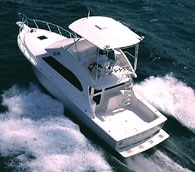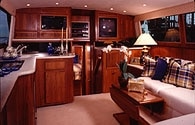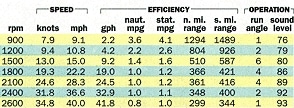
Egg Harbor 37

Egg Harbor 37

Egg Harbor 37 Specs

Egg Harbor 37
The crewmen kept glancing from the gauges to the megayacht to me as I piloted our new Egg Harbor 37 test boat through the tight channel. The closer the yacht got, the faster the glances came. I suppose he was waiting for me to pull back on the throttles. After all, I did have them open to cruising speed, and the megayacht was throwing up a killer wake. But what the heck – I’m supposed to find out as much as I can about every boat I test, and these were the first serious waves we’d seen all day. Besides, that’s what insurance is for, right?
We coasted up the hump of the first wave, hovered for a moment between crests – omigodIshouldasloweddown – and met the next wave head on. No harsh impact, nothing broken, and barely any detectable movement. The most significant result was a minor but sudden slowdown. And in my book, that’s a hallmark of a well-built sportfisherman. Physics prevents you from eliminating the slowdown, but where does that impact land? Does it reverberate throughout the boat, up the bridge and into the helm, and right up your spine? Or is it the wave that gets battered and bruised? In this case, the wave lost.
Inside Edition
What does it take to make a relatively small sportfish into a wave buster? Start by looking where you’ll spend the least amount of time: the engine room. Those stringers you see are fully encapsulated, XL-10, lifetime-guaranteed, rot-free marine plywood, beefed up with stainless-steel plates in the engine beds. Now look up. Between that overhead and the salon sole is honeycomb coring, providing maximum strength with minimum weight. Same goes for the hullsides, which are cored with end-grain balsa from the chine up. The countertops are Corian. The fuel tank is epoxy-coated welded aluminum. Shaft seals are dripless. Is everything in sight made from top-shelf construction materials? You bet, though I did spot one item that should be improved. The stateroom has spring struts on two stowage compartment hatches, and in my experience they break within the first 50 hours of a boat’s on-the-water use. Egg Harbor assures me gas-assist struts will be put on future hatches.
The Highs: Custom-class interior woodwork with bookmatched grain cabinetry. Breaks waves without vibrations or harsh impact. Construction materials and techniques are top shelf.
The Lows: Spring struts on the stateroom hatch will last as long as your first tank of fuel. Nonslip on the sidedecks and bow needs to be more aggressive. A plumbed livewell is an extra grand.
If you’re a boater who spends some time in the engine room, you’ll like the 37’s cockpit entry. No shuffling tables, no seats to remove, no greasy footprints across the salon carpet, as is usually the case on a sportfish this size. There’s enough headroom below to sit up straight while you work on the iron horses, and such amenities as an engine room washdown, an oil exchange system, and primary and secondary fuel filters are all present and accounted for. Better yet, every plumbing and electric line and every seacock is well marked and clearly labeled so you can perform on-the-water repairs without causing more on-the-water problems.
Outer Space
Of course, to handle the seas well a boat must be designed well, and the 37 has some unique tweaks below the waterline. There are steps, for example. No, not the ones you see on kingfish tournament boats or ocean racers. Instead, these steps are in the strakes. What gives? Common sense tells us that aerating the hull bottom will increase speed. But with an inboard sportfish, that means you risk aerating the props. Not good. But the 37’s designers managed to find that just-right sweet spot on the strakes where stepping them increases lift and boosts speed, without shooting bubbles at the screws. And yes, the 37 does perform impressively, running 40 mph at wide open throttle. Compare that to 37.9 mph for the Bertram 390 Convertible ($442,000 with twin 480-bhp Volvo Penta diesel inboards) and 32.6 mph for the Luhrs 360 Convertible ($280,000 with twin 420-bhp Caterpillar diesel inboards). Even better is that the 37’s extra speed doesn’t come at the expense of increased fuel consumption. In fact, it burns slightly less fuel than both the Bertram 390 (which because of its 120 additional horses is to be expected) and the Luhrs, rigged the same.
But wait a sec, the fun hasn’t ended yet. There’s one more special touch below the waterline. The exhaust ports vent through the boat’s bottom. That means exhaust fumes won’t be a problem in the cockpit, even when you’re trolling downwind – they won’t reach nose level until they’re yards behind the boat.
Okay, we’ve seen the high-tech beef put together intelligently, but what about the bouquet? Detail work in the salon is better than expected. When is the last time you spotted bookmatched grain cabinetry, solid-brass fittings, and satin-varnish finish on a 37′ production boat? I expect these touches on megabuck custom jobs and 50′ battlewagons, but in a relatively small production-built convertible, it’s rare. Compare that to the Bertram 390 and the Luhrs 360, which both have their own strengths, including the Bertram’s woodwork with its satin glow and the Luhrs’ low price and impressive list of standard features. You won’t find the bookmatched grain in either of those boats. Nor will you find solid-brass fittings.
Flat Line Strike
Performance, construction, and looks are great. But does the 37 put the “fish” in this fishboat? The cockpit spans 78 square feet. That’s six more than the Luhrs but not enough to beat the Bertram, which has 93 square feet of fish-fighting territory. The 37’s four gunwale-mounted rodholders are Lees, and coaming pads ring the cockpit. The transom houses a livewell; add a grand to list cost to have it plumbed for recirculation, and toss in two more to have the bait box rigged as a bait freezer. The six rocket launchers and spreader lights in the hardtop are included in the top’s $15,950 cost. For more overbuild-it attitude, check out the hinge on the transom door. I’ve seen hinges this size on boats 60′ long; a kicking bluefin won’t bend or break it. Northern anglers and bottom fishers will like the 37’s standard anchor roller (add $4,175 if you want a windlass). But whoever plays anchor boy won’t enjoy going forward to handle the gear. The nonslip on the bow is too slick. I’d like to see a more aggressive pattern used there.
On a boat 37′ long, you might expect to have a problem stowing all your rigs. Not on this baby. Bench seats on the flying bridge lift up to stow your Internationals, and a tackle station in the forward starboard corner of the cockpit provides plenty of room for tackle, too. After you’ve put that tackle to good use, hopefully, you’ll also use the macerated, lift-out fishbox in the deck. It has enough room to hold a dozen gaffer dolphin or four fat yellowfin.
One more thing about that cockpit – it has a plate laminated into the deck for fighting chair reinforcement. Again, a battlewagon feature that’s rare on boats under 40′. Then again, I’m not so sure Egg Harbor’s designers planned to build a 37′ production boat. From the looks of things, they put together a 45′ custom-finished package and managed to fit it into the 37 Convertible.
Last Word: No, it’s not huge and it’s not a custom job – it just looks, feels, and performs that way.
LOA……..40’8″
Beam……..13’6″
Draft……..3’4″
Displacement (lbs., approx.)……25,800
Transom deadrise…..12°
Bridge clearance….12’7″
Minimum cockpit depth ……….2’4″
Max. cabin headroom ……….6’3″
Fuel capacity (gal.)….400
Water capacity (gal.)..80
Price (w/standard power) ……….$342,828
Price (w/test power) ……….$367,866
Standard Power: Twin 330-bhp Cummins V-8 diesel inboards.
Optional Power: Twin diesel inboards to 840 hp total.
Test Boat Power: Twin 420-bhp Caterpillar 3126 in-line-6 diesel inboards with 439 cid, 4.33″ bore x 5.00″ stroke, swinging 24″ x 32″ four-bladed Nibral props through 2.1:1 reductions.
Standard Equipment (major items): Antifouling bottom paint; pressure freshwater system; recessed trim tabs; anchor roller; anchor w/chain and rode; cockpit coaming bolsters; bait prep center w/cutting board, sink, stowage locker, and tackle drawers; fighting chair deck reinforcement; 4 gunwale-mounted Lee rodholders; removable, macerated fishbox; transom livewell; compass; hydraulic steering; oil exchange system; cable TV/ phone jacks; fresh/raw-water washdowns; water heater; 16,000/9,000-Btu, dual-zone reverse-cycle a/c; entertainment center w/TV, VCR, and CD stereo system; 2-burner stove; refrigerator/freezer; microwave; electric head.









